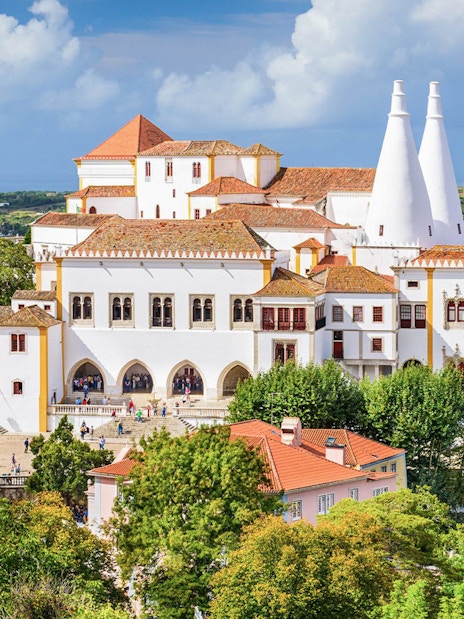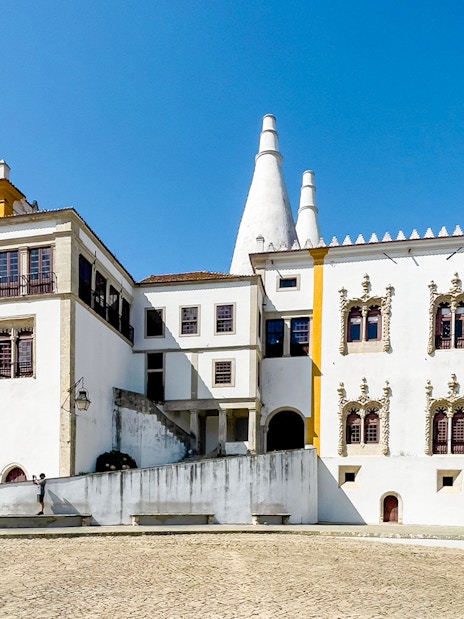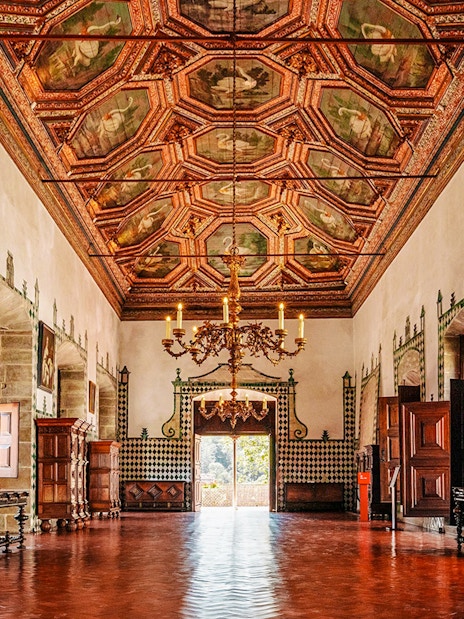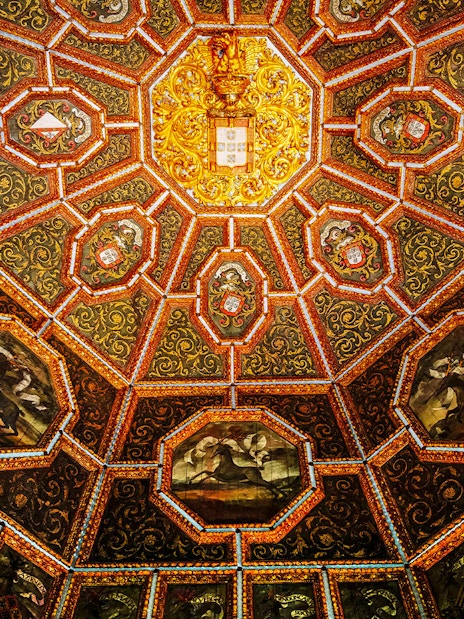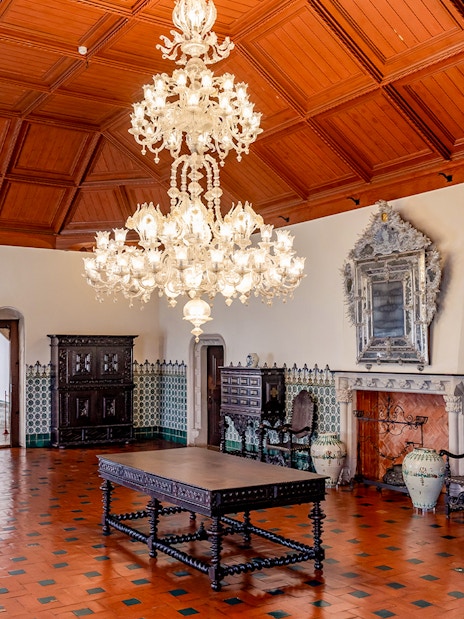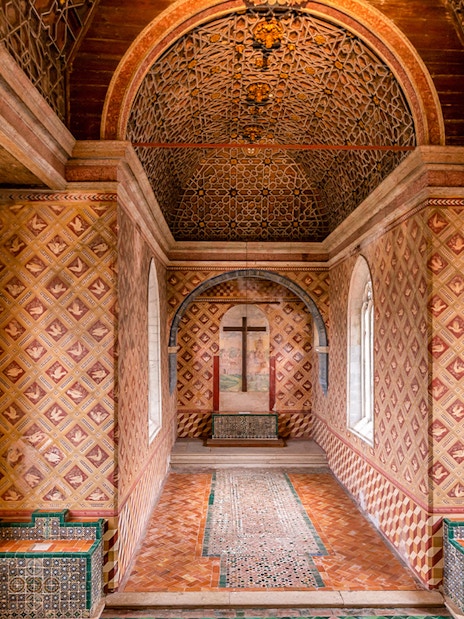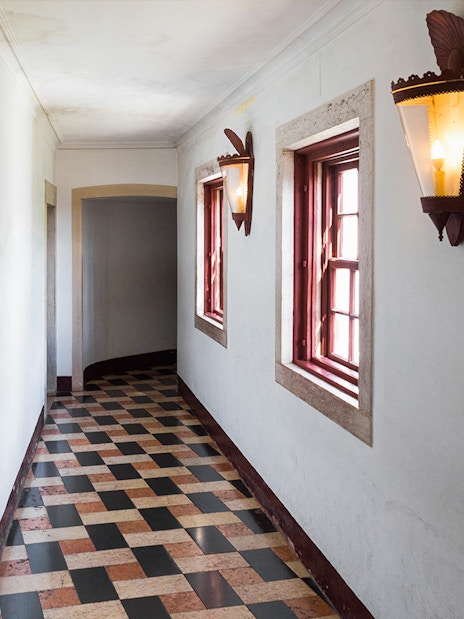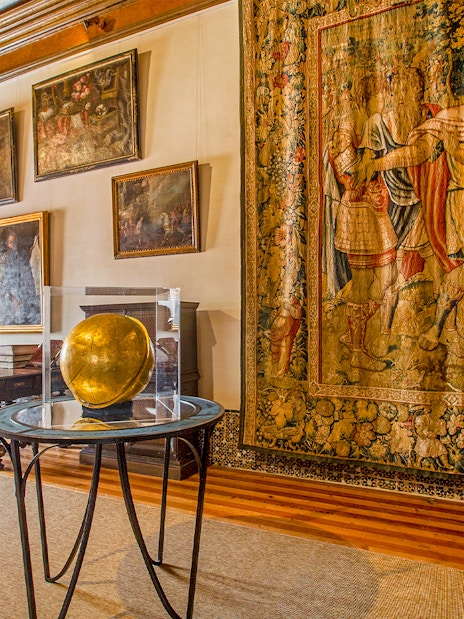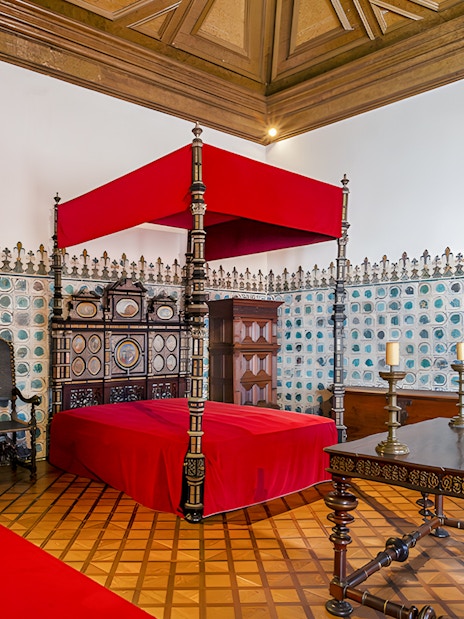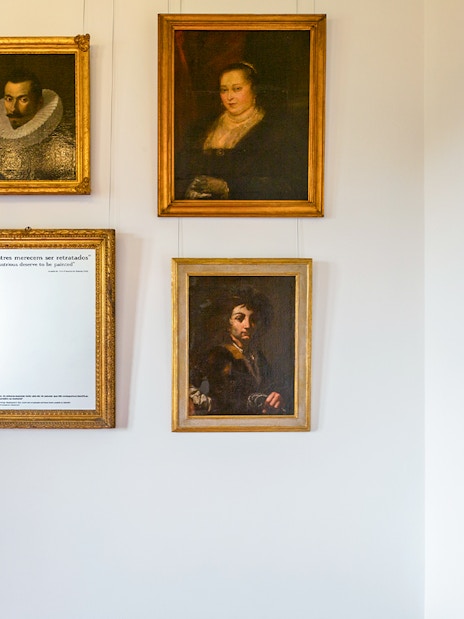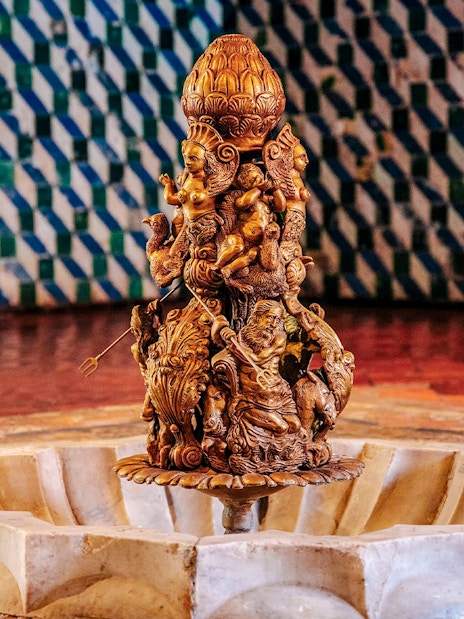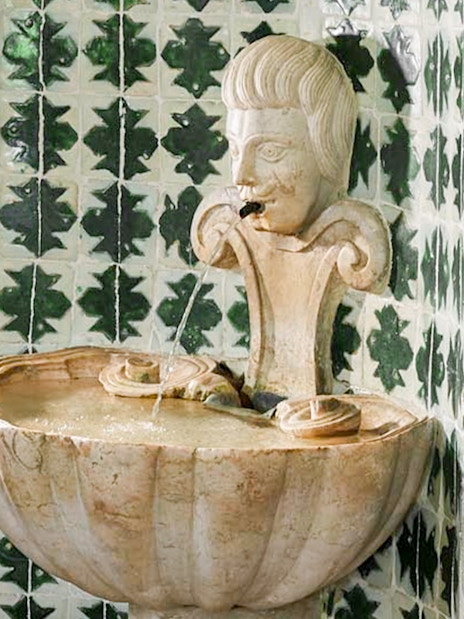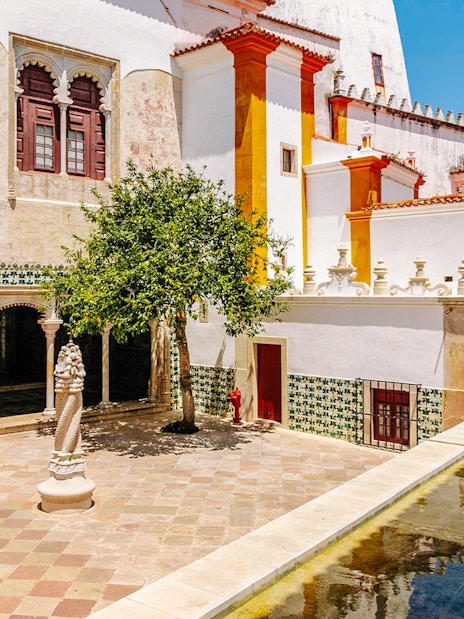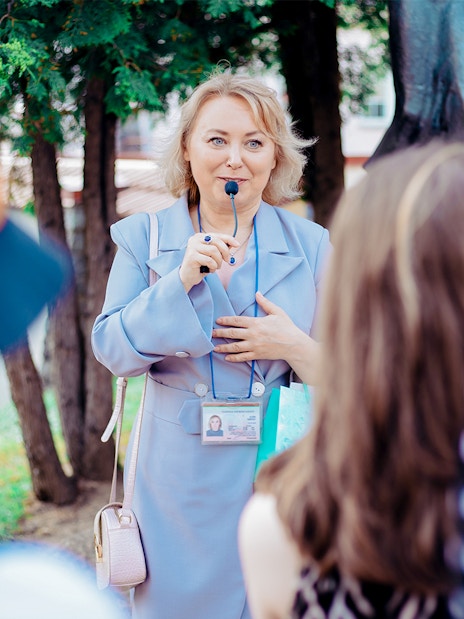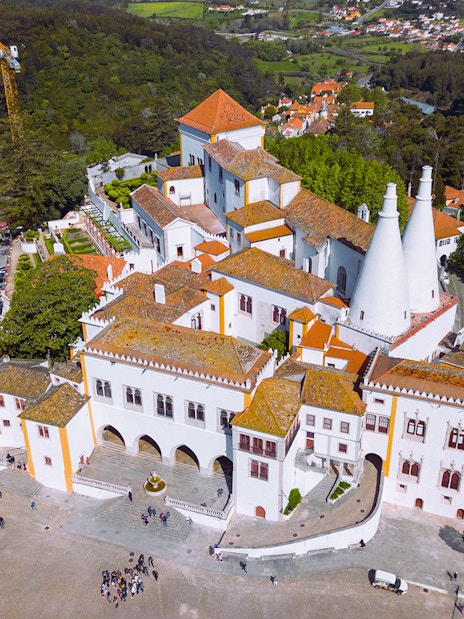The palace has several wings and halls that were constructed for various purposes. The Swan Room was where the royal family hosted musical concerts, public receptions, and even other ceremonies. On the other hand, the Galley Room was most likely designed to be a gallery where King João III would meet with his masters.
Book National Palace of Sintra Tickets
Headout is an authorized and trusted partner of the venue, offering curated experiences to enjoy this attraction.

Tour this iconic Portuguese attraction and take in every little detail at your own pace.
- Soak in the details of Portugal’s best-preserved medieval Royal residence with this entrance ticket to the National Palace of Sintra.
- Your experience begins from well outside the palace, with its towering conical chimneys that you can spot from anywhere in the town of Sintra.
- Explore the intricate fusion of the Manueline, Gothic, and Moorish architectural styles across every room within the palace.
- Explore one of the finest examples of Mudejar architecture at the Palatine Chapel with its stunning hardwood ceiling.
Tour this iconic Portuguese attraction and take in every little detail at your own pace.
- Soak in the details of Portugal’s best-preserved medieval Royal residence with this entrance ticket to the National Palace of Sintra.
- Your experience begins from well outside the palace, with its towering conical chimneys that you can spot from anywhere in the town of Sintra.
- Explore the intricate fusion of the Manueline, Gothic, and Moorish architectural styles across every room within the palace.
- Explore one of the finest examples of Mudejar architecture at the Palatine Chapel with its stunning hardwood ceiling.
Inclusions
- Entry to the National Palace of Sintra
- Free audio guide in Portuguese, English, Spanish, and French
Exclusions
- Guided tour
- Food and drinks
- Transport
- The National Palace of Sintra is accessible to wheelchair users, but some areas might be tricky to reach.
- Choose from audio guides in Portuguese, Spanish, English, and French (as per option selected).
- You will have to download your tickets beforehand while you have access to Wi-Fi.
- Download the free Zoom Guide app before you visit the National Palace of Sintra. It has multilingual audio guides, images, and text that can help you navigate the venue better. You can also download the content and access it offline if you don’t have access to the internet.
- These tickets can't be cancelled or rescheduled.
Combo: National Palace of Sintra + Quinta da Regaleira Tickets
Visit two UNESCO World Heritage Sites with one ticket - easy, seamless, and hassle-free!
- Explore two of Portugal’s best-kept treasures, the National Palace of Sintra and the Quinta da Regaleira, with this money-saving combo.
- With a distance of just 4km between them, you can easily explore both attractions in a single day and enjoy a glimpse into Portugal’s history.
- Since the National Palace of Sintra can get fairly busy, you should visit it first thing in the morning before heading to Quinta da Regaleira.
- Get more insights with the help of audio guides and explore at your own pace.
Visit two UNESCO World Heritage Sites with one ticket - easy, seamless, and hassle-free!
- Explore two of Portugal’s best-kept treasures, the National Palace of Sintra and the Quinta da Regaleira, with this money-saving combo.
- With a distance of just 4km between them, you can easily explore both attractions in a single day and enjoy a glimpse into Portugal’s history.
- Since the National Palace of Sintra can get fairly busy, you should visit it first thing in the morning before heading to Quinta da Regaleira.
- Get more insights with the help of audio guides and explore at your own pace.
Inclusions
National Palace of Sintra
- Entry to the National Palace of Sintra
- Audio guides in four languages: Portuguese, English, Spanish, and French.
Quinta da Regaleira
- Entry to Quinta da Regaleira
- Audio guides in four languages: Portuguese, English, Spanish, and French.
Exclusions
- Guided tour
- Food & drinks
- Transport
National Palace of Sintra
- Those with wheelchairs can access the National Palace of Sintra. However, a few areas might be tricky to access.
- You will have to download your tickets beforehand while you have access to Wi-Fi.
- Download the free Zoom Guide app before you visit the National Palace of Sintra. It has multilingual audio guides, images, and text that can help you navigate the venue better. You can also download the content and access it offline if you don’t have access to the internet.
Quinta da Regaleira
- The palace and gardens are wheelchair accessible, but some areas may be difficult to navigate.
- While pets are not allowed, you can bring your guide dogs along.
- Download the free Zoom Guide app before you visit the Quinta da Regaleira. It has multilingual audio guides, images, and text that can help you navigate the venue better. You can even download the content and access it offline if you don’t have access to the internet.
- These tickets can't be cancelled or rescheduled.
Highlights
Tour the National Palace of Sintra with a guide and explore its stunning interiors.
- Discover all you need to know about the millennia-old history of the National Palace of Sintra through the expertise of your guide.
- Find out what makes the palace so iconic, from its striking conical towers to its intricately designed interiors combining several styles.
- Stroll through the many spaces within the palace, such as the Swan Room, the Coat of Arms Room, and the Palatine Chapel.
- Find out about the palace’s historical and architectural significance in a choice of two languages - English & Portuguese.
Need to Know
- This route is not accessible to wheelchair users.
- Download your tickets beforehand while you have access to Wi-Fi.
- Pets are not allowed at the palace, but you can bring a guide dog along.
Highlights
Tour the National Palace of Sintra with a guide and explore its stunning interiors.
- Discover all you need to know about the millennia-old history of the National Palace of Sintra through the expertise of your guide.
- Find out what makes the palace so iconic, from its striking conical towers to its intricately designed interiors combining several styles.
- Stroll through the many spaces within the palace, such as the Swan Room, the Coat of Arms Room, and the Palatine Chapel.
- Find out about the palace’s historical and architectural significance in a choice of two languages - English & Portuguese.
Need to Know
- This route is not accessible to wheelchair users.
- Download your tickets beforehand while you have access to Wi-Fi.
- Pets are not allowed at the palace, but you can bring a guide dog along.
Inclusions
- Entry into the National Palace of Sintra
- Guided tour in English & Portuguese (as per the option selected)
Exclusions
- Audio guide
- Food & drinks
- Transport
Inclusions
- Entry into the National Palace of Sintra
- Guided tour in English & Portuguese (as per the option selected)
Exclusions
- Audio guide
- Food & drinks
- Transport
- These tickets can't be cancelled or rescheduled.
Combo (Save 5%): Sintra National Palace + Pena Palace & Park Tickets
5% off
Visit Sintra’s iconic landmarks, admire royal art, and enjoy spectacular views.
- Enjoy hassle-free booking with pre-purchased entry tickets to Sintra National Palace and Pena Park.
- Explore two beautiful landmarks in one day—start with the enchanting 200-acre Pena Park and then visit Sintra National Palace.
- Pena Park and Sintra National Palace are easily accessible and it takes 20 minutes by car to travel between the two.
- Upgrade to get an audio guide or walk through the halls of Pena Palace, a 19th-century masterpiece with watchtowers, battlements, and a drawbridge.
Visit Sintra’s iconic landmarks, admire royal art, and enjoy spectacular views.
- Enjoy hassle-free booking with pre-purchased entry tickets to Sintra National Palace and Pena Park.
- Explore two beautiful landmarks in one day—start with the enchanting 200-acre Pena Park and then visit Sintra National Palace.
- Pena Park and Sintra National Palace are easily accessible and it takes 20 minutes by car to travel between the two.
- Upgrade to get an audio guide or walk through the halls of Pena Palace, a 19th-century masterpiece with watchtowers, battlements, and a drawbridge.
Inclusions
National Palace of Sintra
- Entry to the National Palace of Sintra
Pena Palace & Park
- Entry to Pena Palace & Park
- Choose the preferred time for your visit based on how much time it takes to travel between the two Palaces, which is approximately 20 minutes by car.
Pena Palace & Park
- It takes about 30 minutes to walk from the park entrance to the Palace, so plan ahead.
- Security checks at the entrance may take 15-20 minutes, so expect a short wait.
- Private vehicles aren’t allowed—use public transport or shuttle services to reach the site.
- These tickets can't be cancelled or rescheduled.
Which National Palace of Sintra ticket is best for you?

Entry Ticket with Audio Guide
Duration: 2 hours
Audio Guide: Yes
- You get access to the National Palace of Sintra.
- Get a deeper understanding of its history with the audio guide.
- Choose among Portuguese, Spanish, French & English for your audio tour.
Recommended Tours:
National Palace of Sintra Tickets

Guided Tour
Duration: 1 hour
Guide: Yes, in English & Portuguese
- Guided tours are ideal for those who like to get into the nitty gritty of a landmark when they travel.
- Benefit from a well-organized tour that covers all major attractions, along with the odd hidden gem.
- Learn all you want to about the attraction’s history, architecture, and more.

Combo Ticket
Duration: Flexible duration
Audio Guide: Yes
Guide: No
- Save time and cost with a combo rather than buying separate tickets.
- Explore two UNESCO World Heritage Sites with a single ticket.
- Choose to explore both on the same or separate days based on your convenience.
- The National Palace of Sintra is about 4.2km from Quinta da Regaleira, 8km from Pena Palace & Park, and about 17km away from the National Palace of Queluz.
Recommended Tours:
National Palace of Sintra highlights
Palatial Wings and Halls
Plan your visit to the National Palace of Sintra

The National Palace of Sintra and its gardens are open between 9:30am to 6:30pm from Monday to Sunday.
Last admission to the palace is at 6pm.
The palace remains closed on December 24, 25, 31, and January 1.
Address: Largo Rainha Dona Amélia, 2710-616 Sintra, Portugal
You can get to the National Palace of Sintra by bus, train, and car.
- By Train: You can take the CP Sintra line from Lisbon to Sintra. You can get off at Sintra station.
- By Bus: You can take the line 1253 bus or Buses 434/435.
- By Car: If you’re traveling from Lisbon, you can drive via the IC19. Alternatively, you can take the IC30 if you’re traveling from Mafra. The palace is about 30km from the city of Lisbon. If you're traveling from Cascais, you can take the EN9 via the A5.

- Parking: The palace doesn’t have parking of its own. You should ideally park your car near the train station and then rely on public transport to reach the palace.
- Restrooms: You’ll find a few public restrooms that you can use at the palace.
- Restaurants: You’ll find plenty of restaurants and bars in Sintra, which is approximately 3km from the palace.
- Shop: You’ll find a shop at the end of the visiting circuit where you can buy any souvenirs you’d like.
- Photography: You can take photographs at the palace. However, the use of drones and selfie sticks is prohibited.

Sintra has several restaurants, bars, and cafes where you can grab a bite. All of these are a mere 15-20 minutes away from the palace.
- Monserrate: Serving a mix of European and Portuguese food, Monserrate offers an expansive menu and impeccable service.
- Sintra Terrace: The Sintra Terrace serves a delectable mix of burgers, salads, and seafood while offering stunning views of the hills and the National Palace of Sintra.
- Bristol: This warm, locally-owned restaurant offers homely food with everything from meats, seafood, burgers, and even gluten-free options.

- Keep the National Palace of Sintra as the first or last destination in Sintra, as it’s just a 10-minute walk from the Sintra station.
- The palace and gardens are extensive and will involve a fair bit of walking, so don’t forget to put on your most comfortable pair of shoes.
- Buy your National Palace of Sintra tickets online. You’ll save time and won’t have to wait in queues at the ticket counter.
- Flash photography is a big no at the palace, but don’t let this stop you from bringing your camera along to capture some memories.
Beyond the National Palace of Sintra
Frequently asked questions about the National Palace of Sintra
The palace has made efforts to accommodate visitors with mobility challenges, but due to its historic nature, some areas might be less accessible. You can reach out to the palace in advance for more information.
Yes, the palace provides visitor amenities, including restrooms. You’ll also find cafes and restaurants in the town of Sintra where you can enjoy different cuisines.
Yes, you can take photographs inside the palace. However, the use of flash, drones, and selfie sticks is prohibited.
The historic center of Sintra has limited parking, and circulation is restricted to residents. It's recommended to use public transportation or park in designated areas outside the center, such as near the train station, and walk or take local transit to the palace.
Yes, you can get audio guides in Portuguese, Spanish, French, and English to help you dive deeper into the palace’s history and architecture.
Some key attractions within the National Palace of Sintra are the Magpie and Swan Rooms, the Coat of Arms Room, the Crown Room, and the Palace Guard Room.
Sintra enjoys a mild climate year-round, but visiting during the spring or early autumn can offer pleasant weather and fewer crowds. You should visit on a weekday to skip the crowds during the weekends.

